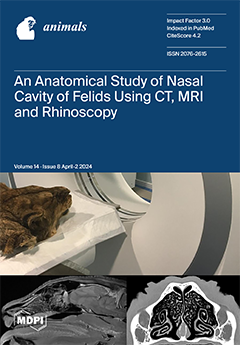Growth-retarded yaks are of a high proportion on the Tibetan plateau and reduce the economic income of farmers. Our previous studies discovered a maldevelopment in the ruminal epithelium of growth-retarded yaks, but the molecular mechanisms are still unclear. This study aimed to reveal how the proteomic profile in the ruminal epithelium contributed to the growth retardation of yaks. The proteome of the ruminal epithelium was detected using a high-resolution mass spectrometer. There were 52 proteins significantly differently expressed between the ruminal epithelium of growth-retarded yaks and growth-normal yaks, with 32 downregulated and 20 upregulated in growth-retarded yaks. Functional analysis showed the differently expressed proteins involved in the synthesis and degradation of ketone bodies (
p = 0.012), propanoate metabolism (
p = 0.018), pyruvate metabolism (
p = 0.020), and mineral absorption (
p = 0.024). The protein expressions of SLC26A3 and FTH1, enriched in the mineral absorption, were significantly downregulated in growth-retarded yaks. The key enzymes ACAT2 and HMGCS2 enriched in ketone bodies synthesis and key enzyme PCCA enriched in propanoate metabolism had lower protein expressions in the ruminal epithelium of growth-retarded yaks. The ATP concentration and relative mitochondrial DNA copy number in the ruminal epithelium of growth-normal yaks were dramatically higher than those of growth-retarded yaks (
p < 0.05). The activities of citrate synthase (CS), the α-ketoglutarate dehydrogenase complex (α-KGDHC), isocitrate dehydrogenase (ICD) in the tricarboxylic acid cycle (TCA), and the mitochondrial respiratory chain complex (MRCC) were significantly decreased in ruminal epithelium of growth-retarded yaks compared to growth-normal yaks (
p < 0.05). The mRNA expressions of
COQ9,
COX4, and
LDHA, which are the encoding genes in MRCC I, IV and anaerobic respiration, were also significantly decreased in the ruminal epithelium of growth-retarded yaks (
p < 0.05). Correlation analysis revealed that the average daily gain (ADG) was significantly positively correlated to the relative mitochondrial DNA copy number (
p < 0.01, r = 0.772) and ATP concentration (
p < 0.01, r = 0.728) in the ruminal epithelium, respectively. The ruminal weight was positively correlated to the relative mitochondrial DNA copy number (
p < 0.05, r = 0.631) and ATP concentration in ruminal epithelium (
p < 0.01, r = 0.957), respectively. The ruminal papillae had a significant positive correlation with ATP concentration in ruminal epithelium (
p < 0.01, r = 0.770). These results suggested that growth-retarded yaks had a lower VFA metabolism, ketone bodies synthesis, ion absorption, and ATP synthesis in the ruminal epithelium; it also indicated that the growth retardation of yaks is related to the obstruction of cellular ATP synthesis in rumen epithelial cells.
Full article






